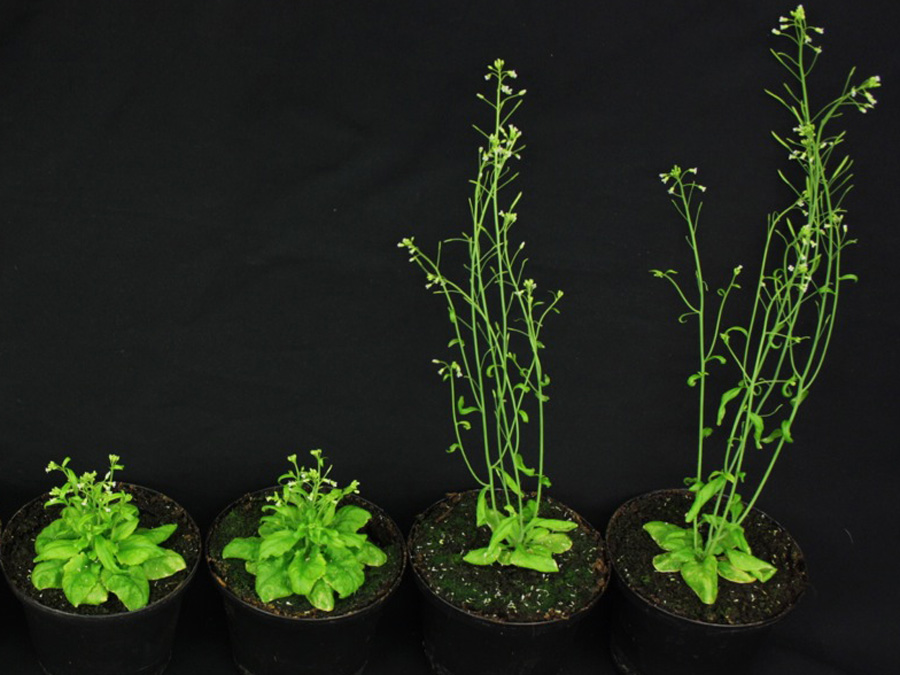Molecular mechanism of plant growth explained
Plant growth requires teamwork between two hormones

For their current investigations, a research group at the Technical University of Munich, supported by scientists from the Helmholtz Zentrum Munich and the TU Braunschweig and headed by Professor Brigitte Poppenberger from the TUM used thale cress (Arabidopsis thaliana), a model research plant. The researchers wanted to examine the molecular mechanisms of brassinosteroids. Although it was well known how brassinosteroids are produced and how their signals are transmitted in plants, it was unclear how the growth promotion process is initiated.
What happens if the plant steroid is damaged?
The scientists used plants with mutations, which impaired the activity of brassinosteroids. They thereby discovered that these plants produced less gibberellin. As a result, the plants’ germination was impaired, their growth inhibited and their flowering delayed. “The brassinosteroids are therefore necessary for the production of gibberellins – a mechanism that is highly relevant to the growth and development of plants,” says Poppenberger, Professor for the Biotechnology of Horticultural Crops. The scientists were able to show that transcription factors are responsible for this mechanism. Transcription factors are proteins that regulate gene expression. Once activated by brassinosteroids, they initiate the production of gibberellin. “We’ve elucidated a molecular mechanism that is fundamental to cell elongation and division in plants,” the head of the research group concludes.
Dwarf cultivars, such as balcony varieties of vegetables like tomatoes and cucumbers, as well as grain varieties were specifically selected for impaired brassinosteroid metabolism, says Poppenberger. “We now understand that these defects interfere with the mechanism of action of gibberellins. In barley, for example, this results in shorter stalks with better stability and higher yields,” Poppenberger explains.
These short cultivars are called semi-dwarf varieties. They were bred as early as the 1950s and 1960s when the primary aim was to improve yields. The Nobel Laureate Norman Borlaug, known as the father of the green revolution, bred short-stalked wheat and rice. Coupled with intensified farming methods, these new crop varieties increased yields fivefold, preventing famines in Mexico and later China.
Brassinosteroids – the key to plant growth
Whereas external application of gibberellins has been utilized in agriculture for several decades, for example, to produce larger fruits or to obtain seedless fruits like grapes or tangerines, brassinosteroids have not been used in this manner. It would be too expensive. However, in plant breeding varieties with defects in brassinosteroid activity have been selected for, barley being a prime example. “These findings are an important step toward improving our understanding of how plant steroids work – and harnessing their potential for the breeding and production of crop plants,” says Brigitte Poppenberger.
Publication:
Unterholzner, S.J., Rozhon, W., Papacek, M., Ciomas, J., Lange, T., Kugler, K.G., Mayer, K.F., Sieberer, T. and Poppenberger, B. (2015). Brassinosteroids are master regulators of gibberellin biosynthesis in Arabidopsis.
DOI: 10.1105/tpc.15.00433
Contact:
Prof. Dr. Brigitte Poppenberger
Technische Universität München
Biotechnology of Horticultural Crops
Tel.: +49 8161 71-2401
brigitte.poppenberger@wzw.tum.de
http://bgk.wzw.tum.de
Technical University of Munich
Corporate Communications Center
- Sabine Letz
- sabine.letz@tum.de
- presse@tum.de
- Teamwebsite